
Bottles like these were sold on eBay with wonderful descripors like “Naval Vessel Boarding bottles” or “Pirate Hand Grenades”. These are new. They come in a variety of whimsical shapes (many appearing further down on this page). It’s possible they were blown in Persia/Iran – but from everything I’ve seen, they were never intended to hold contents.
A fake, or not a fake?
Being a Late Persian Saddle Flasks is not the easiest thing to be!! To North American/Western European eyes, late Persians are oddly shaped, so pretty much any oddly shaped bottle, real or fake, runs the risk of being lumped in with authentic (intended for use as vessels, not decorative display pieces of glass) late Persian saddle flasks.
And I’ve struggled with understanding which pieces in my collection were real, and which were fake. As of September 2014, I have a collection with about 300 Late Persians, about 100 fake Late Persians, and a handful of pieces of glass that might be, might not be. And that set of might be/might not be is a constantly shifting set. Although some are so obscenely awkward that they are obviously fake, others just leave me confused as to whether they are recent production intended for use, or recent production intended to fool people. Part of the research project is to pull together a broad sample of fakes (forgeries, reproductions, what have you) to help those who follow.
I’ve noticed a couple things…
- Almost every pre-20th century Late Persian with spiral threading has threading that runs clockwise, not counter-clockwise – even if it is only one turn. I would love to hear from a glassblower as to when the threading was likely applied in the glassmaking process, which hand was spinning the blowpipe or the pontil rod, and which hand was applying the glass threading. It appears almost every glassblower had the same technique, or the same dominant hand.
- Authentic transport bottles – or at least every one I own – do not have fire-polished lips. They were snapped off the pontil rod, the stringing was applied, and off they went to work. The two that I own that I consider “fake” have smooth polished lips – they are “too fine”.
- 19th century and older saddle flasks, authentic ones, seem to always have an inner lip or ledge that came about as a part of the lip-finishing process. Newer saddles (20th century saddles and some that I consider questionable) never seem to have this ledge. Some of the newer ones don’t even have round openings – leading one to wonder how the bottle ever could have been sealed?
- As with any other form of glass, honest basal wear and legitimate internal content stain bring great joy. Some of the bottles on this page are here because they might almost seem “good enough” to be real, except that all of the ones I own are pristine – no basal wear, no content stain. I know bottles well enough to know that the best chance is that I’m not that lucky to have mint originals – I more likely have mint fakes.
- If you’ve held enough old glass, you can almost “taste” the difference – you know what I mean or you don’t – and there are relatively few that can fool you in person. I have less than a dozen on my shelves that I’m unsure about. Of course this “tasting” doesn’t help the beginner – even if you are an old hand at glass collecting, I can assure you, you are once again a neophyte when you start playing with Late Persians. But after enough time, you start to tell. My daughter can tell. She even found an authentic piece in my fakes collection (yes, I have that many fakes, and YES, I am that proud of my daughter who, at 15, can find an authentic Late Persian small flask among shelves of fakes).
Not ALL Late Persians are fake – but some of them are. It does not surprise me that, without tenacity and unless you are prepared to buy a fair bit of modern “junk” in the process, few people will stick with it long enough to assemble a sizeable Late Persian collection. You get stung by fakes constantly. And sometimes, that highly unique specimen that you’ve loved so much…turns out to be a dud. I’ve had that happen more than once.
Hopefully this area of the site will offer some insights to help you answer your questions.
Smalls
These ones are tougher to assess. I may someday find out that the bottle on the left in Photo 1 below is real. But I’m doubtful. No wear, no stain on these two. And the glass is “oily” – unlike the originals, and has far more amber swirling. Additionally, the ebay seller that sold me the bottle on the left was selling (April 2013) another Persian Small that was clearly fake, even from the photos – the glass quality was just wrong.
Photo 2 confuses me a bit. It does have the vertical ribbing, which makes me really want to like this bottle. However – the stringing goes counterclockwise, the pontil mark is wrong (glass-tipped), the stringing is round and not flattened and does not have the characteristic “teardrop” start point. There is some basal wear, although from the dust on the stringing, that may only because it sat in a dealer’s shop for so long!
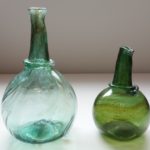 1 1 |
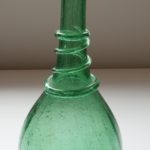 2 2 |
Transport Bottles
These ones are starting to make the rounds of eBay and Etsy…their lips are smooth polished, they have no wear, no stain whatsoever…they are VERY pretty – I keep my pair in the living room because the glass truly is beautiful – but they’re new, to my eyes. And I don’t have confidence they were made for use.
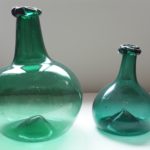 1 1 |
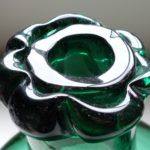 Lip Finish Lip Finish |
Oddities
Photos 1 and 2 were likely made by a regional glassblower in the UK as a whimsey in the mid to late 20th century. They are metallic in sheen, and completely foreign – the glass almost looks plastic.
Photos 3 through 15 are 20th century whimseys. I say so quite knowingly – I own almost 100 of them, having mistakenly thought from grainy photos that they were new (to me, but not “new”, as they are) and weird variants of transport bottles (oddly, there were four original transport bottles mixed in with them – so who could blame me for thinking, with crappy cellphone photos, that I had hit the mother lode?). They are all new. They show up on eBay regularly with odd descriptions – like they were found “in a barn” (because the antique/junk shoppe they bought them out of was barn-shaped?). Poorly executed, for the most part, they aren’t Late Persian, nor are they Saddle Flasks.
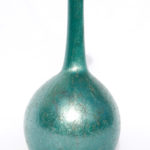 1 1 |
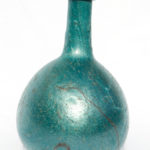 2 2 |
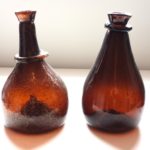 3 3 |
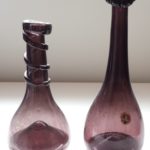 4 4 |
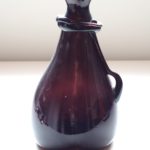 5 5 |
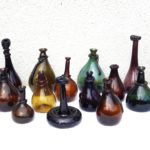 6 6
|
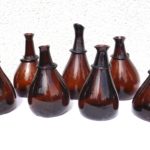 7 7 |
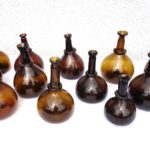 8 8 |
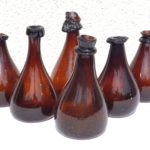 9 9 |
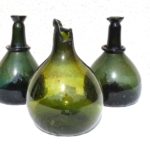 10 10 |
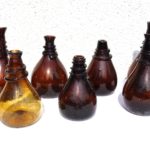 11 11 |
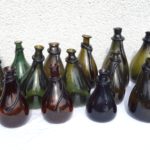 12 12 |
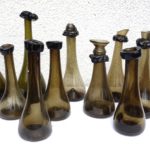 13 13 |
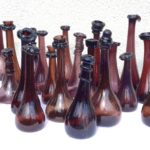 14 14 |
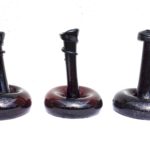 15 15 |
Amber Saddle Flasks
My strong suspicion is that these amber flasks are 20th century. These were probably blown in Persia, but I do not believe they have any real age to them. In fact, I have one in a different yellow-amber that came directly from the Isfahan region, with staining and wear. But I am not certain that all were intended for use.
In the photos below, I highlight several key features that are consistent across this poorly manufactured amber glass; features that are NOT there in the amber glass that I have high confidence was used in the rose water, shirazi wine, and other industries in Persia in the 17th through 19th centuries.
- Several of the bottles have tiny nodules on the lips – bubbles of solid glass that would never have survived the first usage (Ambers 6, Ambers 7, Ambers 8, Ambers 9, Ambers 10). It’s curious that none of these imperfections have snapped off.
- Almost all of the saddle flasks are sunken, to some degree (Ambers 1, Ambers 2, Ambers 3). There’s a sloppiness to them. Some even fold in on themselves, creating crevasses that would have held dirt. There is none of the quality or uniformity that appears across the older glass.
- Many of the smalls have necks that are extremely thick (Ambers 15). The openings are extremely small – often less than half the diameter of the top of the bottle is opening; the other half is glass.
- Several of the saddle flasks have what I call a “scotch tape” effect – it looks like a piece of clear tape was adhered to the body – but it wasn’t – it’s an imperfection in the glass (Ambers 14).
- The glass itself has an inconsistency in the colour (Ambers 11) – often an “oily-ness” to it – and either the glass or the colour looks as though oil was applied.
- The stringing is very inconsistent – thick to thin to thick again, and the wrap doubles back over itself – it’s very sloppy (Ambers 4, Ambers 5). The stringing on the older bottles was evenly applied. And the stringing often is ridged, rather than smooth.
- The wear marks, if any, are often very crude – like the bottle was rubbed on a concrete floor (Ambers 12, Ambers 13).
- The smalls have vertical ribbing, The appearance of vertical ribbing on these bottles forces me to remove vertical ribbing as a tell-tale sign that a bottle is old. In fact, what it has done is called into question the age of all of the other bottles in the collection that DO have vertical ribbing, mostly light aqua smalls. But all of the light aqua smalls make sensible use of glass – the glass at the lip is thin, perhaps 1/8 the total diameter of the neck, and not obscenely thick like we see on the amber flasks, below.
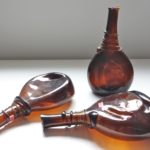 Ambers 1 Ambers 1 |
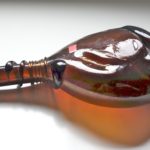 Ambers 2 Ambers 2 |
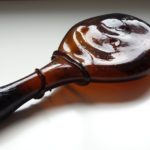 Ambers 3 Ambers 3 |
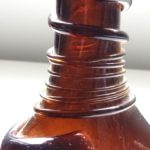 Ambers 4 Ambers 4 |
 Ambers 5 Ambers 5 |
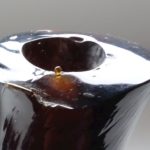 Ambers 6 Ambers 6 |
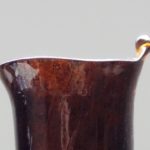 Ambers 7 Ambers 7 |
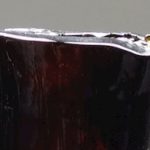 Ambers 8 Ambers 8 |
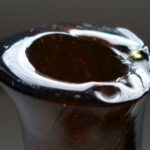 Ambers 9 Ambers 9 |
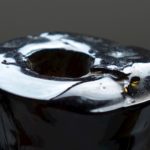 Ambers 10 Ambers 10 |
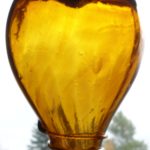 Ambers 11 Ambers 11 |
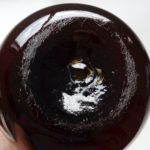 Ambers 12 Ambers 12 |
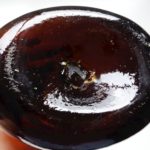 Ambers 13 Ambers 13 |
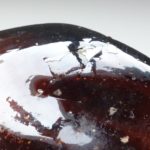 Ambers 14 Ambers 14 |
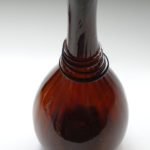 Ambers 15 Ambers 15 |

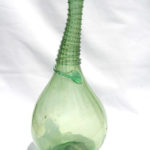
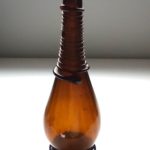
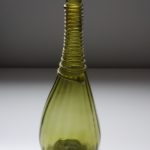
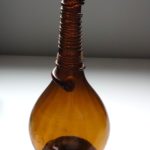
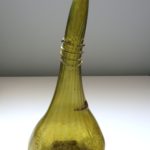
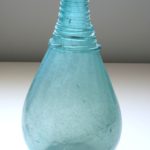
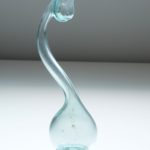
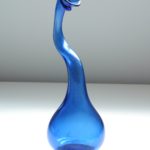
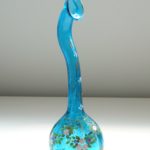
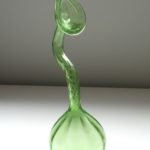
Hi
Thx for sharing your knowledge.
is there any way i can send you a photo of a glass i have?
I brought it from iran long a go.
Thanks.
Medi.